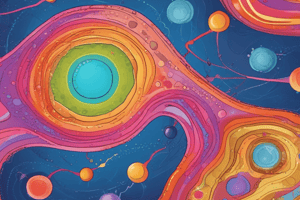Podcast
Questions and Answers
What is the fundamental unit of life that cell biology focuses on?
What is the fundamental unit of life that cell biology focuses on?
- Cells (correct)
- Tissues
- Molecules
- Organelles
Which organelle is responsible for energy production in a cell?
Which organelle is responsible for energy production in a cell?
- Mitochondria (correct)
- Ribosomes
- Endoplasmic reticulum
- Nucleus
What type of cell division produces sex cells like eggs and sperm?
What type of cell division produces sex cells like eggs and sperm?
- Meiosis (correct)
- Cytokinesis
- Mitosis
- Apoptosis
What is the purpose of metabolism in a cell?
What is the purpose of metabolism in a cell?
Which process reduces the number of chromosomes by half during cell division?
Which process reduces the number of chromosomes by half during cell division?
What part of a cell is responsible for protein synthesis?
What part of a cell is responsible for protein synthesis?
What are the signaling molecules used by cells for communication?
What are the signaling molecules used by cells for communication?
Which type of reproduction involves the fusion of egg and sperm?
Which type of reproduction involves the fusion of egg and sperm?
What structures in the male reproductive system produce sperm?
What structures in the male reproductive system produce sperm?
Which process does not involve fertilization?
Which process does not involve fertilization?
Where does fertilization typically occur in human reproduction?
Where does fertilization typically occur in human reproduction?
What is the role of the placenta during prenatal development?
What is the role of the placenta during prenatal development?
Flashcards are hidden until you start studying
Study Notes
Biology: Exploring Cell Biology and Human Reproduction
Introduction to Biology
Biology is the study of life, encompassing everything from the smallest cells to entire ecosystems. At its foundation lies the basic structure and function of cells, which form the building blocks of living organisms. From there, the study broadens to explore the diversity of life, from microorganisms to mammals, and delves into the intricate processes that govern life cycles, growth, and reproduction.
Cell Biology
Cell biology focuses on the structure, function, and interactions of cells, the fundamental units of life. It covers the following aspects:
-
Cell Structure: Cells are composed of various organelles, which are specialized subunits that perform specific functions. Examples include mitochondria for energy production, endoplasmic reticulum for protein synthesis, and nucleus for DNA storage.
-
Cell Division: The process by which cells produce copies of themselves is called mitosis. Meiosis is another type of cell division that produces sex cells (eggs and sperm) and reduces the number of chromosomes by half.
-
Metabolism: The set of chemical reactions that occur within a cell to maintain life forms the basis of metabolism. These reactions convert nutrients into energy that fuels cellular processes and waste products are expelled from the cell.
-
Cell Communication: Cells communicate with one another through various signaling molecules called hormones, neurotransmitters, and growth factors. This communication allows cells to coordinate their activities within tissues and organs.
Human Reproduction
Human reproduction is the biological process by which humans produce offspring. It involves both sexual and asexual means of producing new individuals. Some key aspects of human reproduction include:
-
Sexual Reproduction: Involves the fusion of two haploid gametes (egg and sperm) to form a diploid zygote, which develops into an embryo before being born as a baby.
Sexual reproduction requires a combination of genetic material from both parents, resulting in offspring with unique traits inherited from both parents.
-
Asexual Reproduction: Occurs without fertilization and does not involve the production of eggs or sperm. Examples include budding (in some species of yeast) and parthenogenesis (found in certain insects).
-
Reproductive Systems: Male and female reproductive systems have specialized structures and functions designed for the production, storage, and transport of gametes. For example, male reproductive systems produce sperm, while female reproductive systems produce eggs and provide a protective environment for fetal development.
-
Fertilization and Embryonic Development: After fertilization occurs in the fallopian tube, the zygote travels down the uterus and implants itself into the endometrium, where it undergoes rapid division and differentiation, forming the embryo and eventually giving rise to the baby after birth.
-
Prenatal Development: From conception until birth, the developing embryo and fetus grow rapidly, going through multiple stages of organ formation and maturation. Pregnancy is maintained by the placenta, which provides nourishment and oxygen while removing waste from the fetus.
In conclusion, biology encompasses a wide range of topics, including cell structure and function, metabolism, cell communication, and human reproduction. Understanding these fundamental principles helps us appreciate the complexity of life and how it has evolved over billions of years.
Studying That Suits You
Use AI to generate personalized quizzes and flashcards to suit your learning preferences.




